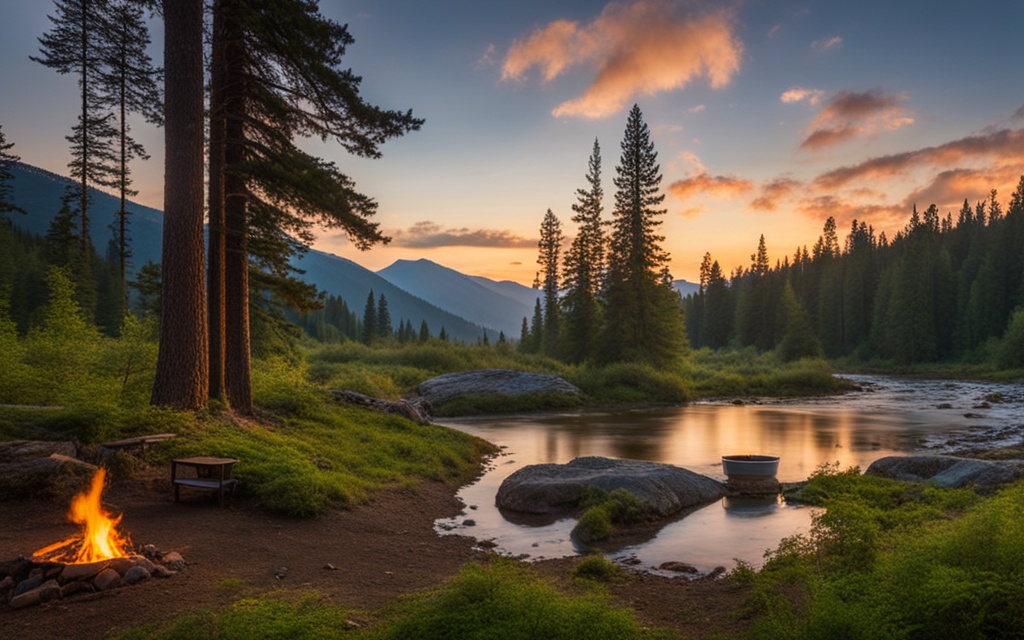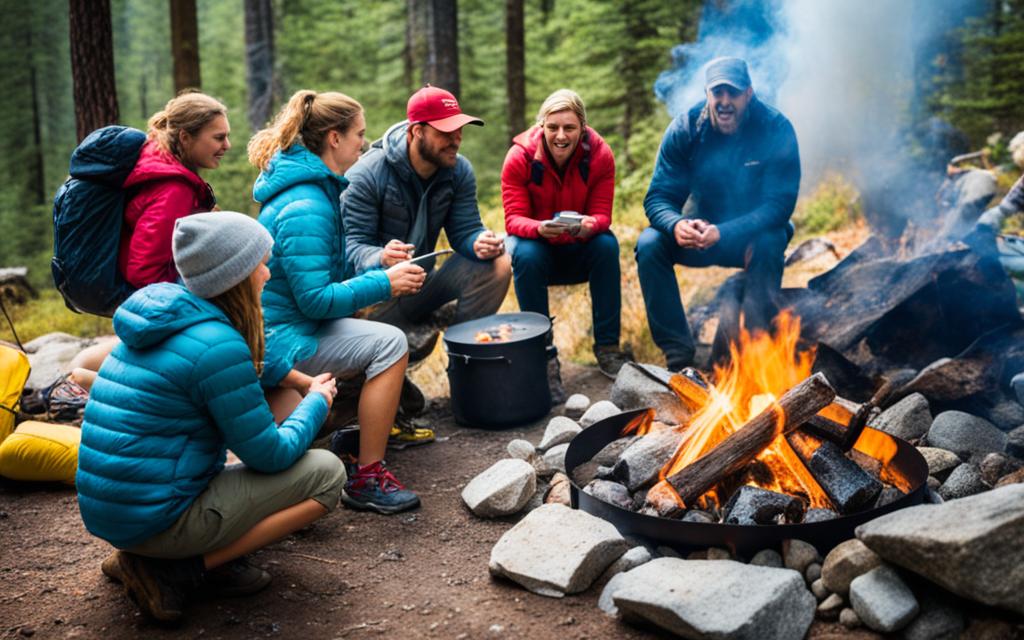Exploring the great outdoors through dispersed camping in national forests is a unique and rewarding experience. It’s perfect for both seasoned campers and those new to outdoor adventures. This guide will give you all the essential info to plan your next free camping trip in America’s national forests.
We’ll cover everything from the benefits of dispersed camping to the rules you need to follow. By the end, you’ll know how to make the most of your time in these beautiful public lands.

Table of Contents
Key Takeaways
- Dispersed camping in national forests provides the opportunity for privacy, freedom, and immersion in nature.
- The US Forest Service manages 175 national forests and grasslands, offering abundant options for free and remote camping experiences.
- Dispersed camping typically means no amenities, requiring campers to adhere to Leave No Trace principles for responsible land use.
- Understanding the rules and regulations for dispersed camping in national forests is crucial to ensure a safe and sustainable adventure.
- Preparing with the right gear and supplies is key to a successful dispersed camping trip in the great outdoors.
What is Dispersed Camping in National Forests?
Dispersed camping, also known as boondocking or dry camping, means setting up your campsite in undeveloped areas within national forests. It’s different from camping in designated campgrounds. [https://thedyrt.com/magazine/lifestyle/free-camping-national-forests/]
With dispersed camping, you can find remote, untouched sites. You get to enjoy the wilderness with fewer people and less amenities.
Understanding the Difference Between National Forests and National Parks
National parks have strict rules, but national forests are more flexible for dispersed camping. The U.S. Forest Service manages 154 national forests and 20 grasslands across 44 states, including Puerto Rico. Visitors can camp outside of designated areas in most of these places, unless it’s forbidden.
The Benefits of Dispersed Camping in National Forests
Dispersed camping in national forests offers solitude, a closer connection to nature, and saves money. You can find secluded sites away from crowds for a peaceful experience. Plus, it’s usually free, making it a budget-friendly way to enjoy the outdoors.
But, it also means you need to be more self-sufficient. You’ll have to manage your own waste, purify water, and keep safe from fires without campground support.
“Dispersed camping allows us to find remote, untouched sites and immerse ourselves in the wilderness with minimal crowds and amenities.”
Finding and Accessing Dispersed Camping Sites
Finding the perfect spot for dispersed camping in national forests is an exciting adventure. With some research and exploration, we can find those hidden gems. These spots offer the ultimate off-the-grid experience.
Online tools like USFS maps, the Dyrt PRO, and Google Earth are great for starting your search. They help us find locations and understand the terrain. After getting a general idea, it’s important to visit the local ranger station. They can give us the latest info on conditions and rules.
Then, we should follow forest access roads and look for pull-offs or clearings where people have camped before. These are often the best places to set up. The key is to be ready to search for the perfect spot that matches our adventurous spirit.
| Resource | Description |
|---|---|
| USFS Maps | Topographic maps from the U.S. Forest Service to identify potential dispersed camping areas. |
| The Dyrt PRO | A comprehensive app that provides information on dispersed camping locations and user reviews. |
| Google Earth | Satellite imagery and terrain data to explore and plan dispersed camping adventures. |
| Local Ranger Stations | Visit ranger stations to get up-to-date information on conditions, regulations, and suitable dispersed camping sites. |
With some preparation and a sense of adventure, we can find the hidden gems of dispersed camping in national forests. We can enjoy the ultimate off-the-grid experience. Whether it’s a secluded spot by a serene lake or a scenic overlook, the thrill of finding dispersed camping sites and accessing dispersed camping sites is all part of the journey.

Dispersed camping national forests: Rules and Regulations
Going on a dispersed camping trip in the U.S. national forests means following certain rules. These rules help protect these beautiful lands. We must follow the Leave No Trace principles. This means taking our trash with us, disposing of waste properly, and keeping our impact small.
Leave No Trace Principles
- Pack out all trash and waste
- Properly dispose of human waste by burying it at least 6 inches deep
- Minimize our impact on the natural environment
- Respect wildlife and avoid disturbing their habitats
- Leave the campsite as we found it, or even better
Fire Safety and Campfire Regulations
Campfires are a key part of dispersed camping, but we must handle them with care. We should only use deadfall for firewood and check for any fire bans. It’s important to use fire pans or rings and make sure the fire is fully put out before leaving.
Having the right gear, like a bucket, shovel, and water, is key for fire safety in these areas.

“Campfires must be completely extinguished before leaving the site. Proper equipment, such as a bucket, shovel, and water, is essential for fire safety.”
There are more rules than just Leave No Trace and fire safety. We need to look into pet policies, how long we can stay, and what equipment is allowed. Always talk to the local ranger station before heading out to make sure we follow all the rules.
Preparing for Your Dispersed Camping Adventure
Getting ready for dispersed camping in national forests is crucial. It’s different from camping in developed spots because you need to be more self-sufficient. Make sure you have all the dispersed camping gear and dispersed camping supplies you need for a comfy and successful trip.
Essential Gear and Supplies
For a great dispersed camping trip, pack these must-haves:
- A sturdy, high-quality tent to protect you from the elements
- Warm and insulated sleeping bags and pads for a good night’s sleep
- A camp stove and fuel to prepare your meals
- A reliable water filtration system or purification tablets to ensure clean drinking water
- Proper food storage containers to keep your provisions safe from wildlife
- A comprehensive first-aid kit for any unexpected emergencies
- Navigation tools like a compass, map, and GPS device to avoid getting lost
- Sun protection such as sunscreen, hats, and sunglasses
- Appropriate clothing and layers to accommodate changing weather conditions
With the right dispersed camping gear and dispersed camping supplies, you’ll be ready to enjoy the outdoors. You’ll have a safe and comfy trip, surrounded by nature’s beauty.
“Proper planning and packing will ensure a comfortable and successful dispersed camping experience.”
Conclusion
Dispersed camping in national forests is a special way to enjoy nature. It offers solitude, saves money, and connects us with the outdoors. This guide has shown you how to plan a free camping trip in these forests, whether you’re experienced or new to camping.
More people are choosing dispersed camping for its freedom and quiet. It might have challenges like rough roads or no amenities. But, the benefits make it all worth it. By following Leave No Trace principles, we keep dispersed camping available for everyone.
We might see more efforts to manage dispersed camping sites in the future, like a $70 yearly fee. But, there’s a need for more support and funding. By understanding the rules and helping take care of the land, we can keep dispersed camping open for all.
FAQ
What is dispersed camping in national forests?
Dispersed camping means camping outside of regular campgrounds in national forests. It lets you find remote spots and enjoy nature with fewer people around. You’ll have to bring all your gear and find your own spot.
What are the benefits of dispersed camping in national forests?
Camping away from the crowds has many perks. You get to feel closer to nature and save money compared to campgrounds. It’s a way to find peaceful spots that are all yours, and it’s usually free.
How can I find and access dispersed camping sites in national forests?
Finding these spots takes some work and exploration. Use tools like USFS maps, the Dyrt PRO, and Google Earth to spot possible areas. Then, visit ranger stations for the latest info on where to go and what to expect.
Once you have a spot in mind, follow the forest roads. Look for places where other campers have stayed before. These spots are likely to be good for camping.
What are the rules and regulations for dispersed camping in national forests?
There are rules to follow to protect these beautiful lands. You must follow Leave No Trace principles. This means taking your trash with you, disposing of waste properly, and keeping the area clean.
There might be rules about campfires, pets, and how long you can stay. Always check with the ranger station before you go.
How should I prepare for a dispersed camping adventure in national forests?
Be ready for a camping trip that requires you to be self-sufficient. Bring a strong tent, sleeping gear, a camp stove, and a way to filter water. Don’t forget your first-aid kit, navigation tools, and sun protection.
Good planning and packing will make your trip comfortable and fun.
